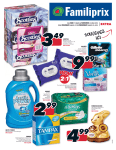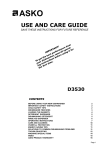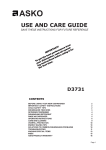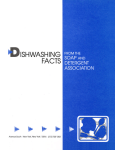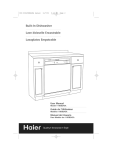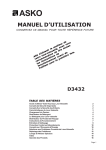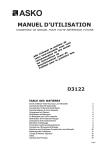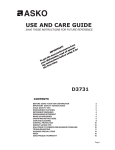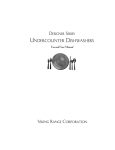Download Haier HDB18EB User's Manual
Transcript
® What The World Comes Home To TM Built-In Dishwasher HDB18EB Pots & Pans Power Indicator Rinse Haier Rinse & Hold Normal Wash Light Wash On Glassware Off Lave-Vaisselle Encastrable Lavaplatos Empotrable User Manual- Model # Guide de l'Utilisateur- Modèle # HDB18EB Manual del Usuario- Modelo # English IMPORTANT SAFETY INSTRUCTIONS Warning – To reduce the risk of fire, electric shock, or injury to persons when using your appliance, follow basic precautions, including the following: 1. Read all instructions before using the appliance. 2. Use this appliance only for its intended purpose as described in this use and care guide. 3. Use only automatic dishwashing detergent and rinse agent recommended for use in this appliance and keep them out of the reach of children because they are corrosive and can be harmful. 4. This appliance must be properly installed in accordance with the installation instructions before it is used. 5. Never unplug your appliance by pulling on the power cord. Always grasp the plug firmly and pull straight out from the outlet. 6. Replace immediately worn power cords, loose plugs/power outlets. 7. Unplug your appliance before cleaning or before making any repairs. 8. Do not open the dishwasher door immediately after completion of wash process or during the operation as hot air/steam may cause personal injury. Press the door latch, wait few seconds by allowing cold air to go in and then open the door. 9. Do not operate your appliance in the presence of explosive fumes. 10. Do not add or mix any flammable or explosive substances to the wash. 11. Appliance loading door must be closed during the operation of the machine. 12. Do not operate your appliance when parts are missing or broken. 13. Do not use this appliance for commercial dishwashing purpose. 14. Do not operate this appliance unless all enclosure panels are properly in place. 15. Do not tamper with controls. 16. To reduce risk of injury do not allow children to play in or on the appliance. Close supervision of children is necessary when the appliance is used near children. 17. This appliance must be connected to proper electrical outlet with the correct electrical supply. 18. Proper grounding must be ensured to reduce the risk of shock and fire. DO NOT CUT OR REMOVE THE GROUNDING PLUG. If you do not have a three-prong electric receptacle outlet in the wall, have a certified electrician install the proper receptacle. The wall receptacle MUST be properly grounded. 19. Hydrogen gas may be produced if the water heater has not been used in more 1 English then 2 weeks. This could be explosive and can explode under certain circumstances. If this is the case, turn on all the hot faucets and let the hot water run for a few minutes before using this appliance. This will let the trapped hydrogen escape. To avoid an accident, as hydrogen gas is flammable and can explode, do not turn on an electric appliance, smoke, light a match/lighter or use a flame. 20. Do not repair or replace any part of the appliance or attempt any servicing unless specifically recommended in the user-repair instructions that you understand and have skills to carry out. 21. To reduce the risk of electric shock or fire, do not use extension cords or adapters to connect the unit to electrical power source. 22. Do not wash any heat sensitive or any other items that are not designed for automatic dishwasher. Items not dishwasher safe could become deformed or melt and create a potential fire hazard. 23. Do not use this dishwasher outdoors. 24. Do not leave the dishwasher door open to dry dishware while children are around the counter top. Close supervision and observation needed when children are around the dishwasher. 25. Do not abuse, sit on or stand on the door or dish rack of the dishwasher. 26. Do not touch the heating element during or immediately after use, as it may be very hot. 27. Load sharp objects such as knives and forks upside down to reduce the risk of cut type injuries. 28. Do not wash plastic items unless they are marked dishwasher safe. Check the manufacturer’s recommendations for items not marked. 29. Do not load sharp items near the door; you could damage the door seal. 30. When removing an old dishwasher from service or discarding it, remove the front door. 31. Disconnect electrical power and water inlet hose to dishwasher before servicing. SAVE THESE INSTRUCTIONS 2 English Table Of Contents PAGE SAFETY INSTRUCTIONS ................................................................1-2 Knowing Your Dishwasher ........................................................4-6 Using Your Dishwasher ............................................................7-16 Understanding The Filtration System ........................................17 Dishwasher Safe or Hand Wash ..........................................18-20 Care & Cleaning Of Your Dishwasher ......................................21 Troubleshooting........................................................................22-26 Warranty ........................................................................................27 Thank you for purchasing our Haier product. This easy-to-use manual will guide you in getting the best use of your dishwasher. Remember to record the model and serial number. They are on a label in back of the dishwasher. Model number Serial number Date of purchase Staple your receipt to your manual. You will need it to obtain warranty service. All figures in this use & care manual are for illustration purposes only. The illustrated parts shown in figures may be different on the actual unit. Specifications and features are subject to change without prior notice. 3 English Knowing Your Dishwasher Parts and Features (Front View with Open Door) 1 2 3 5 5 11 6 10 7 9 8 1. Deluxe Adjustable Upper Rack with Stemware Holders 7. Pre-Wash Detergent Compartment 2. Middle Spray Arm 9. Triple Filtration System (Located at the bottom under Lower Rack) 3. Pressure Relief Valves (One located at the upper left corner (not shown) 8. Main Wash Detergent Compartment 4. Lower Rack 10. Heating Element (Located at rear and under lower rack) 5. Removable Split Silverware Basket 11. Lower Spray Arm 6. Rinse Aid Compartment 4 English (Front View with Door Closed) HDB18EB POTS & PANS Power indicator Haier Rinsee RINSE& HOLD NORMAL WASH LIGHT WASH ON GLASSWARE OFF 1 2 3 4 HDB18EB Pots & Pans Power Indicator Rinse Haier Rinse & Hold Normal Wash Light Wash On Glassware Off 1. Power On Indicator Light 2. Power Button (On/Off) 5 3. Rinse Check Indicator Light 4. Wash Selector Knob English (Rear View) 5 4 1 2 3 1. Drain Hose (Factory Attached) 2. Electrical Connection Junction Box (120v/60Hz - Plug not Included) 3. Rear Leveling Legs 4. Water Inlet 5. Rear Insulation Panel 6. Safety precaution must be grounded 6 English Using Your Dishwasher POWER Understanding the Dishwasher Control Panel: Power Button: • Press "POWER" button in to turn the power "ON". • Press this button again to turn the power "OFF". Note: You will see the "Power On Indicator Light" lit when the unit is on. “Rinse “ Indicator Light: √ • When “RINSE ” indicator light is lit, this means the rinse aid detergent is empty in the rinse aid compartment. You need to refill rinse aid at this time. RINSE Door Latch: HDB18EB POTS & PANS • To lock the door, push the door with light force until you hear the “Click.” Power indicator Rinsee Haier RINSE& HOLD NORMAL WASH LIGHT WASH ON GLASSWARE OFF • To unlock the door, squeeze the door latch and pull towards you. Wash Selector Knob: • When selecting a wash cycle, turn the knob "CLOCKWISE" to your desired setting by matching the knob "Pointer" symbol to the cycle "dot" symbol. Once both are lined up, press "Power" button to begin the wash process. (You will hear "Click" and the wash cycle will start automatically.) A “Click” will signify the automatic start at the wash cycle. POTS & PANS RINSE& HOLD NORMAL WASH LIGHT WASH GLASSWARE Warning: The wash selector knob is designed to work only in a clockwise direction. DO NOT turn the knob "COUNTER CLOCKWISE." Turning in a counter clockwise direction may cause damage to the wash selector. Selecting Wash Cycles • Select the appropriate cycle based on the load and soil level. For your convenience, the dishwasher has Pots & Pans, Normal, Light Wash, Glassware and Rinse & Hold wash cycles that you can select from. 7 English Pots & Pans Wash Cycle: • This cycle is used for heavily soiled pots & pans, cookware, dishware, silverware and glassware items with dried-on or baked-on soils. Note: This cycle may not remove burned-on foods. POTS & PANS RINSE& HOLD NORMAL WASH LIGHT WASH GLASSWARE Normal Wash Cycle: • This cycle is used for medium or heavily soiled dishware, glassware and silverware. Light Wash Cycle: • Pre-Rinsed dishes & silverware. Glassware Wash Cycle: • This cycle is used for lightly soiled glassware, chinaware. Rinse & Hold Cycle: • This cycle is used for rinsing partial loads that will be washed later. Note: Do not use detergent with this cycle. 8 English Check List for Wash Process 1) Make sure all items are loaded in the racks and silverware basket properly. Note: Do not load tall dishware or cookware items near middle spray arm as they may block the spray arm from rotating. 2) Pour the proper amount of detergent into the detergent dispenser. Note: If "RINSE " indicator light display is "ON" indicating that it is empty, add "Rinse Aid" agent at this time. 3) Close the door and latch properly. 4) Select the desired wash cycle by matching the knob "Pointer" to cycle "Dot". Once you are at this point, turn the power button "ON". You will hear a "Click" and the wash process will begin at this time. 5) To turn the power off at the end of the cycle, simply press the "POWER" button. 6) If you want to speed up the drying process after completion of the cycle, keep the door open slightly to release the moist air. Warning: Keep children away from the machine when the door is opened to dry the dishware because the moist hot air exiting out of the door may cause harm. Canceling or Resetting Wash Cycle Note: The dishwasher will release detergent automatically within a few minutes of the start of a wash. To avoid the "release of detergent" before you cancel or reset the wash cycle, you must press "POWER" button immediately. • Once you have reset to a new wash cycle, you must refill the detergent compartment if it is open and empty because the detergent from previous wash cycle may have already been released. Follow the steps below to cancel or reset a wash cycle: 1) To cancel or reset a wash cycle, press "POWER" button to "OFF" position to turn the dishwasher off. You will notice that power indicator display light shuts off. Note: "HI-TEMP WASH" option can not be selected with "RINSE & HOLD" cycle. 9 English 2) To reset a wash cycle, turn the knob "Clockwise" to your desired wash cycle setting. 3) Press "POWER" button again to the "ON" position to turn the dishwasher on. You will hear a "Click" that signifies the automatic start of the wash process. You will also notice that power indicator display light turns on. Pausing a Wash Cycle: The "POWER" button serves the purpose of the "Pause" function as well as powering the machine on or off. If you need to pause in the middle of the cycle to add or remove any items, follow the steps below: 1) Press "POWER" button to the "OFF" position to pause the cycle. You will notice that the power indicator display light shuts off. 2) Open the door by squeezing the door latch slowly. Note: Do not open the door until the water spray action stops. Be careful of moist hot air that may rise out of the dishwasher. 3) Add or remove items. Once you have finished adding or removing, simply close the door properly. 4) Press the "POWER" button to the "ON" position to resume the cycle. You will notice that power indicator display light turns on. Open Door Protection: Your dishwasher will stop automatically if the door is opened during the operation. The dishwasher will not start until the door is closed again. Once the door is closed the cycle will resume automatically. 10 English Preparing to Wash Dishes: For get best results, practice the following before you put dishware in the dishwasher: • Discard big chunks of food from the plate before loading. • Remove sticky foods and loosen burned-on foods before loading. • Empty liquids such as juice, soup, soda, coffee or tea from glasses and cups before loading. • Rinse off acid based liquid, such as vinegar or lemon juice right a way. Failure to do so may cause discoloration to plates, food containers or internal cabinet. • Always check manufacturer’s recommendations before you start washing items. Tips to avoid stains and films: The following suggestions are recommended to prevent stains and films on dishware and utensils items: • You must rinse all dishware, silverware, glassware and food containers immediately after use. Some citric based food products, coffee, tea and iron deposits in water can cause yellow or brown film to form on the inside surface it left on for a long time or if rinsed immediately. • You must check your water hardness to see whether you need to use more or less detergent to wash. If water is extremely hard, then it may be causing stains on items. You may need to use a water softener. • Do not overload the dishwasher. • Avoid improper loading. • Be sure to use the recommended water temperature to wash dishware. • Do not use too little detergent. • Do not use old or damp powder detergent. • Do not load aluminum utensils improperly. Aluminum utensils can cause gray or black marks to appear on porcelain utensils if they are touching during wash cycle. 11 English Loading the Lower & Upper Rack: To get maximum cleaning results, follow the recommendations below before you start the dishwasher: Note: Do not wash any heat sensitive or any other items that are not designed for automatic dishwashers. (upper rack) • Keep all tall dishware and food containers away from the spray arm rotation. • Place food containers such as cups, glasses, bowls, saucepans and casserole dishes with soiled surface facing in the downward position. • To avoid any type of damage to glassware such as coffee/tea cups, beverage, wine and champagne glasses, do not load them on the bottom rack. Place these items on the upper rack. • Put cups upside down on the top of the cup/stemware rack and put wine or champagne glasses upside down between the divided segments of the cup/stemware rack to secure them properly. • Do not load dishware or food containers that are made of wood or iron. These items are not considered dishwasher safe.(See chart on p.18 for details.) • Do not jam the glassware items together when loading. (lower rack) • Place delicate items on the upper rack. • Do not load tall dishware or cookware items near the middle spray arm. • Move racks slowly in and out to avoid slamming the dishware items together. • Make sure all dishware and glassware items are securely in place when loading to avoid falling over or striking against each other. Adjustable Upper Rack System: The upper rack has two positions, which allows you to modify the rack system according to your current space needs. The flexibility of the upper rack is ideal for washing tall dishware and glassware items. For Example: Adjusting the Rack to the Lower Position allows you the flexibility to load taller wine or champagne glasses in the upper rack, simply remove the rack and bring it to the lower position. 12 English For Example: Adjusting the Rack to Upper Position allows you the flexibility to load tall dishes on the lower rack. Steps to Remove the Rack 1) Open both sides of the rail guards from the upper rack. 2) Slide the rack out. 3) Close both sides of the rail guards so rack will not slide out. Loading Silverware Basket: Simply remove the basket out of the dishwasher to load silverware and place it back once you finish loading. • To avoid any type of injury, load knives and forks face down. • Try to mix spoons, knives and forks for better cleaning and drying and to prevent nesting. • Do not mix stainless steel and silver items because you may damage silver finish on silver items. • Do not load tall items next to upper spray arm because it could be blocked. • Do not load dishware or food containers that are made of wood or iron. These items are not considered dishwasher safe. • Do not load tin, pewter and non-dishware filters. These items are not considered dishwasher safe. 13 English Proper Use of Detergent: • The amount of detergent to use depends on the type of water in your living area whether it is hard or soft and whether items are lightly or heavily soiled. • Water softness or hardness is measured in grains content per gallon (gpg). You can find out the gpg level by calling your local Environmental Protection Agency (EPA) in your county. • If you find that the gpg level is higher in the water, then the water will be harder in your living area. You will need more detergent to clean. If gpg level is lower, then the water will be softer in your living area so you will need less detergent to clean. See the following table to understand the "water hardness type" and gpg level. Water Hardness Type Hard Medium Soft gpg 10+ 4-9 0-3 Note: If gpg level is over 12, then water is very hard. You may need water softener to improve the water quality and the performance of your dishwashing. Note: The quality of the detergent will make a big difference in the cleaning of dishes. Detergent that is damp or too old will not be as effective to clean because the active ingredients will be phased off. Detergent will not work properly. Note: Use only "Automatic Dishwasher Detergent" for your dishwasher. Other types of detergents that are not for dishwasher use may cause oversudsing and foaming. Do not use detergents that are dried, caked or moist. These types of detergents will not dissolve properly and and will clean effectively. 14 English Pouring Dishwasher Detergent: Use the recommended amount of detergent for your wash loads. Measure and pour the detergent into the large compartment for the main wash. The detergent for the pre-wash goes into the small compartment next to the main wash compartment. Note: For the pre-wash you should use one-half the amount of detergent that you use for the main wash. • We recommend that you use a Rinse Agent to help remove spots and prevent new film build-up on your dishes, glasses, flatware, cookware and plastic. compartment door lever main wash detergent compartment prewash detergent compartment detergent compartment lid Note: Use only a liquid form of rinse agent in the dispenser. Pouring Liquid Rinse Agent into the Dispenser: Use the recommended amount of rinse agent for your wash loads. The rinse agent dispenser is located next to the detergent dispenser. During the wash cycle, it automatically releases a preset amount of rinse agent during the last rinse cycle. When the dispenser is full, the see through rinse agent level indicator will be dark. When it is empty, it will be clear which means you need to pour in more. rinse agent level indicator rinse agent compartment Full 3/4 Full (at this time you should refill to eliminate spotting) 6 15 5 4 3 2 1 1/2 Full 1/4 Full Empty Note: A full dispenser should last approximately one month. If you want to adjust the amount of rinse agent dispensed, the dispenser has 1 to 6 levels that you can adjust to. Simply rotate the dial to your desire settings. English Checking Water Temperature: • Your incoming water must be between at least 120˚F / 49˚C and at most 150˚F / 66˚C in order to clean effectively and prevent damage to your dishware. Note: The minimum incoming temperature must be at 120˚F/49˚C in order for the detergent to dissolve properly. If you are unsure of the temperature of your hot water: 1. Simply open the hot water faucet and let it run for a minute and fill a glass. 2. Take a thermometer and check the temperature of the water. 3. If the temperature is below 120˚F / 49˚C, then you need to adjust the water temperature on your water heater in order to maintain that temperature level. Overflowing Protection: • In case the water level is rising above the highest acceptable point, the security pressure switch will activate the drain pump automatically. 16 English Understanding the Filtration System For your convenience, the three level filtration system is conveniently located inside the dishwasher tub beneath the lower rack and consists of a Main Filter, Coarse Filter and Fine Filter. Main Filter Coarse Filter Fine Filter Main Filter: The purpose of this filter is to trap food and soil particles. Coarse Filter: The purpose of this filter is to trap large items such as pieces of bone or glass that might clog the drain. (attached to main filter) Fine Filter: The purpose of this filter is to trap and hold tiny soil and food residue and prevent it from being re-deposited on the dishes during a cycle. Warning: Never run your dishwasher without the filters in place. Failure to do so may cause drain blockage and pump damage. 17 English Dishwasher Safe or Hand Wash Materials Type Aluminum Dishwasher Safe Yes No X Cast Iron X Comments Explanations Some restrictions apply. Read manufacturer's washing instructions before loading. Materials such as anodized aluminum may fade or become dark in hot water temperature. Some discoloration may appear. Load aluminum items away from other type of materials items because they can cause gray or black marks. Not recommended - Hand Wash Only, dry immediately after washing. Iron will rust in water and the seasoning will be lost due to the hot water temperature. Chinaware X Some restrictions apply. Read manufacturer's washing instructions before loading. Note: Only if stated "Dishwasher Safe" (Some restrictions apply.) You can wash "Chinaware" items that are without decoration. You can wash "Chinaware" items with decoration protected by special type of "Glaze". Any type of "Pattern" on top of glaze with gold or silver lining or design may fade in hot water temperature. Load these type of items away from each other to avoid scratches and damage. Copper X Read manufacturer's washing instructions before loading. Load cooper items away from stainless steel items. Do not mix cooper and silver items in the same basket. They can easily discolor. Not recommended - Hand Wash Only. Read manufacturer's washing instructions before loading. Certain type of "Lead Crystal" may etch in high hot water temperature. Do not wash "Antiques" and "Very Delicate" items in the dishwasher. Crystal Items are recommended to be washed in low temperature setting. When loading, make sure they are securely in place to avoid falling over and knocking against other dishware items during the wash process. Crystal X 18 English Dishwasher Safe or Hand Wash (continued) Materials Type Dirilyte (Gold Colored Flat Ware) Dishwasher Safe Yes No X X Disposable Plastic Glassware X Knives X Lead Crystal X Non-Dishware X Non-Stick Coatings Pewter 19 X X Comments Explanations Not recommended - Hand These items may become Wash Only. discolored. Read manufacturer's washing instructions before loading. Not recommended - Hand Wash Only. Read manufacturer's washing instructions before loading. Some exceptions and restriction apply. Read manufacturer's washing instructions before loading. These items are not made for machine wash. Not recommended - Hand Wash Only in cold water. Note: Sharp knives can become dull in hot water temperature. Read manufacturer's washing instructions before loading. Sometimes the knife "Handle" (wood or other type of materials) may crack, loosen or wear out in hot water temperature. You may wash some glassware items to avoid stains. Empty liquids such as juice,soup, soda, coffee or tea from glasses and cups before loading. These items may "Etch" if Not recommended - Hand machine washed. Wash Only. Read manufacturer's washing instructions before loading. Not recommended - Hand Wash Only. Read manufacturer's washing instructions before loading. Never machine wash items such as electronic "air cleaners/filters" of any kind of small electronics/appliances. Some exceptions and restriction apply. Read manufacturer's washing instructions before loading. Note: Only if stated "Dishwasher Safe". After wash, it is recommended that you wipe off the non-stick surface area with vegetable oil to maintain its non-stick quality. This will stain or discolor if Not recommended - Hand machine washed. Wash Only. Read manufacturer's washing instructions before loading. English Dishwasher Safe or Hand Wash (continued) Materials Type Plastic Dishwasher Safe Yes No X Silver & Silver Plated X Stainless Steel X Explanations Only if stated "Dishwasher Safe". Read manufacturer's washing instructions before loading. Place plastic items away from sharp items to avoid damage. It is recommended to place plastic items on the top rack. Do not heat dry. Do not wash "Disposable" plastic items. Note: Rinse these items immediately. If you are going to wash them later because acidic or salty foods may stain if left on for long time. Do not place silverware and stainless steel items in the same basket. Silverware items may get damaged if they come in contact with stainless steel items. Note: Rinse these items imme- Do not place silverware and diately if you are going to stainless steel items in the wash them later because same basket. Silverware items acidic or salty foods may may become damaged if they stain if left on for a long time. come in contact with stainless Note: Do not mix stainless steel items. Do not load and silverware items.Read different types of "Stainless" manufacturer's washing items in the same instructions before loading. load/basket. Metal X Wood Comments X Not recommended. Note: It will rust. Do not wash "Metal Tin" in Read manufacturer's washing the dishwasher. instructions before loading. Not recommended. Note: Only if stated "Dishwasher Safe" Read manufacturer's washing instructions before loading. Wood may crack or lose its shape in machine wash due to the hot water temperature condition. 20 English Care & Cleaning of your Dishwasher General Cleaning and Maintenance: • Do not use abrasive, harsh cleaners, solvents, concentrated detergents or metal scouring pads to clean the inside of dishwasher. • Use warm soapy water with a soft brush or a piece of cloth to clean the interior of a tub. • Clean around the tub gasket with a damp cloth. • When cleaning the control panel, use a slightly dampened cloth to wipe. Then dry thoroughly. • When cleaning the exterior cabinet, use slightly soapy water with a soft piece of cloth. • Do not use any sharp objects that can scratch the cabinet surface. Cleaning Dishwasher Filters: • We recommend that you wash and clean all three filters gently in hot, soapy water and rinse them thoroughly periodically to clean soil and chemical build up on the filters. • The filters are located inside the dishwasher at the bottom in the front below the lower rack. • After a wash and dry cycle is finished, you must wait few minutes until the dishwasher is completely cooled off in order to remove the filters to clean. • Remove the lower rack first in order to take the filter out. • Remove and clean any residue off the filters with soap and water; then wipe them off with a soft piece of cloth. • After you finish cleaning the filters, place them back to their original position in the dishwasher. Preventing Your Dishwasher from Freezing: You must protect your dishwasher if it is left in an unheated place during the winter. • You must cut off electrical power to the dishwasher. • You must turn off the water supply and disconnect the water inlet line from the water valve. • You must drain water from the water inlet into the sink or pan. • Do not install or operate your dishwasher where the temperature is below freezing. • If you receive a delivery of a dishwasher when the outside temperature is below freezing, do not operate it until the dishwasher has warmed to room temperature. Storage of Your Dishwasher in a Cold Environment: • You must store the dishwasher at room temperature. 21 English Troubleshooting Dishwasher does not work: • Check if the circuit breaker needs to be reset or if the fuse needs to be replaced. • Check if the unit is in "OFF" mode. • Check if the door is open. You may need to close the door properly. • Check that you have pressed "POWER" button after proper selection. Dishware and glassware/flatware are cloudy and not properly cleaned: • Use of old or poor detergent. You need to make sure that detergent is fresh. • The water may be hard in your area. You may need to install a water softener. • Spray arms may be blocked. You may need to rearrange dishware and utensils. • Water pressure may be low. You may need to adjust the water pressure. Make sure it is between 20 to 120 (PSI). • Water temperature may be lower than what is recommended. (120 Degree F / 49 Degree C) You may need to adjust the water temperature on your water heater. • Overloading of dishware. You may need to rearrange or remove some dishware from the load. • (May have selected wrong cycle.) Inappropraite cycle selection. You may need to select the proper cycle. Dishes are not dry: • Low water temperature. You may need to regulate the water temperature to 120 Degree F / 49 Degree C. • Make sure the rinse agent dispenser is filled and the proper amount is used. • Avoid nesting and do not overload. • Load items in a tilted position if possible so the water will run off easily. • Dishware washed in higher temperatures will dry faster. • Some plastic materials may need to be towel dried. 22 English Dishware is chipped: • This is due to poor loading or overloading. You need to be careful when loading. Do not overload. You need to place the glassware securely against the pins. Make sure delicate items are on the side rack. We recommend that fine chinaware or crystal items be hand washed. • Do not jam the glassware items together when loading. • Place delicate items on the upper rack. • Do not load tall dishware items near the middle spray arm. • Move racks slowly in and out to avoid slamming the dishware items together. • Make sure all dishware and glassware items are securely in place when loading to avoid falling over or striking against each other. Noise: Some of the sounds you will hear are normal. • You will hear the sound of the water fill and rinse. • You will hear the drain pump motor operation to pump water out. • You will hear the motor stopping at the end of the cycle. • If some utensils are not secure in the rack, you will hear that they are being tossed around the tub. Oversudsing: This is due to the use of regular hand washing detergent. Detergent should be for "Automatic Dishwasher Use". You must use the proper detergent for best dishwashing results. Dishware Odor: • This is due to an incomplete cycle. You need to allow the cycle to be fully completed. • New scented detergent used. This is normal because different types of detergents may have different fragrances. 23 English Etching: • Too much detergent used. Use the appropriate amount of detergent. Reduce the amount of detergent used per load. • The water temperature is too hot. You need to lower the water temperature. • Use of old detergent. Read the expiration date. Avoid using old detergent. Use only fresh detergent. • Do not pre-rinse the dishes. Simply scrape off large food particles Stained interior tub: • Some detergents contain colorants known as "pigments" or "dyes" that will discolor the tub with extended use. You need to change the detergent to one without a colorant. Read the container label carefully before using the detergent. • Some acid based and/or paste based foods may discolor the tub. Use of the rinse cycle may help to decrease the level of staining. Spots & filming found on flatware/glassware: This is due to: • Use of too little detergent. • Low incoming water temperature and pressure. • Improper loading. • Use of old, moist and damp powder detergent. • Hard water in your area. 24 English Water Draining Problem: • Check the level of the drain hose. The drain hose should be positioned above the drain in order to drain properly. Make sure it is on a high drain loop (20”) above the sub floor or floor. • If the drain hose is bent or shrunken, it may affect water draining. • If water can not be drained out smoothly, the dishwasher operation will be disturbed and it may stop in the middle of the cycle. • Make sure that the wash cycle is fully completed before you opened the dishwasher door. If the wash cycle is not completely finished, allow the cycle to be completed and check again. • Make sure that the air gap is not blocked. • If the unit is connected to a garbage disposer, make sure that it is not full. If it is, you need to empty it. • Check for any type of blockage near the drain and dishwasher filter area. • If the water backs up into the sink, you need to check the garbage disposer and the trap for blockage. • It is normal to find some water in the sump area near the drain. Steps of draining the water out of the tub: 1) Shut off the unit power and wait a few seconds. 2) Turn the knob to the “RINSE & HOLD” wash-cycle button. 3) Turn the power on again and you will hear a water draining noise. 4) Let the water drain out for approximately 30 seconds and shut off the unit power. 5) If there is still some water in the tub, repeat steps 1-3 again until the water is completely drained. 6) If you still notice excessive water present in the tub after completing these steps, call the Haier Customer Satisfaction Center for further assistance. 1-877-337-3639 25 English Dishwasher is leaking: • Dishwasher is not properly leveled. You need to place the dishwasher on a flat hard surface. Avoid an uneven surface. • Make sure the dishwasher is properly leveled . (See the installation instructions) • Do not overfill the detergent or the rinse agent dispenser because it will cause oversudsing and overflowing. • Do not use regular type hand or dish washing detergent in the detergent dispenser. These types of detergents are not recommended for dishwasher use. Dishwasher will not fill: • Check the water supply. Make sure that the water supply is in "ON" position. • Check water pressure. Make sure the water pressure is at the proper level. (Between 20 – 120 PSI) Water found under the filter: • A small amount of water found under the filter area after completion of the cycle is normal. Detergent found in the compartment: • Do not load items too close to the detergent compartment. This may block the automatic release of the detergent. • Do not use old or caked/dried detergent in the compartment because it will not dissolve properly and will leave a sandy residue on dishware. Dishwasher is running for too long: • The temperature of incoming water is below 120˚F. Raising your water heater setting will help to shorten the time of operation. • Call the Haier Customer Satisfaction Center if this does not resolve the problem. 26 English Limited Warranty In-Home Service 1 Year Warranty For 12 months from the date of original retail purchase, Haier will repair or replace any part free of charge that fails due to a defect in materials or workmanship, including labor. 2 Years Limited Warranty Water Distribution System (Parts Only) For 24 months from the date of original retail purchase, Haier will replace any parts in the water distribution system which fail due to manufacturing defect. This includes the pump, motor, lower wash arm, middle wash arm and the wash tower upper sprayer with associated supply tube and filters. NOTE: Associated outside inlet and drain plumbing parts are not covered by this warranty. Vinyl Coated Racks (Parts Only) For 24 months from the date of original retail purchase, Haier will replace vinyl-coated upper or lower rack that peels or rusts due to a manufacturing defect. Rotary or Electromechanical Control (Parts Only) For 24 months from the date of original retail purchase, Haier will replace rotary/electromechanical control that fails due to a manufacturing defect. Lifetime (Parts Only) Stainless Steel Tub and Door Liner Provide a replacement tub or door liner if the original tub or door liner fails to contain water because of a manufacturing defect. NOTE: This warranty commences on the date the item was purchased and the original purchase receipt must be presented to the authorized service representative before warranty repairs are rendered. Exceptions: Commercial or Rental Use Warranty 90 days labor from date of original purchase 90 days parts from date of original purchase No other warranty applies For Warranty Service Contact your nearest authorized service center. All service must be performed by a Haier authorized service center. For the name and telephone number of the nearest authorized service center please call 1-877-337-3639. Before calling, please have the following information available: Model number and serial number of your 27 appliance (found on the rear of the unit on the upper left hand side). The name and address of the dealer you purchased the unit from and the date of purchase. A clear description of the problem. A proof of purchase (sales receipt). This warranty covers appliances within the continental United States, Puerto Rico and Canada. What is not covered by this warranty: Replacement or repair of household fuses, circuit breakers, wiring or plumbing. A product whose original serial number has been removed or altered. Any service charges not specifically identified as normal such as normal service area or hours. Damage to dishware. Damage incurred in shipping. Damage caused by improper installation or maintenance. Damage from misuse, abuse accident, fire, flood, or acts of nature. Damage from service other than an authorized Haier dealer or service center. Damage from incorrect electrical current, voltage or supply. Damage resulting from any product modification, alteration or adjustment not authorized by Haier. Adjustment of consumer operated controls as identified in the owners manual. Hoses, knobs and all attachments, accessories and disposable parts. Labor, service transportation, and shipping charges for the removal and replacement of defective parts beyond the initial 12-month period. Damage from anything other than normal household use. Any transportation and shipping charges. THIS LIMITED WARRANTY IS GIVEN IN LIEU OF ALL OTHER WARRANTIES, EXPRESSED OR, INCLUDING THE WARRANTIES OF MERCHANTABILITY AND FITNESS FOR A PARTICULAR PURPOSE The remedy provided in this warranty is exclusive and is granted in lieu of all other remedies. This warranty does not cover incidental or consequential damages, so the above limitations may not apply to you. Some states do not allow limitations on how long an implied warranty lasts, so the above limitations may not apply to you. This warranty gives you specific legal rights, and you may have other rights, which vary, from state to state. Haier America New York, NY 10018 IMPORTANT Do Not Return This Product To The Store If you have a problem with this product, please contact the "Haier Customer Satisfaction Center" at 1-877-337-3639. DATED PROOF OF PURCHASE, MODEL # AND SERIAL # REQUIRED FOR WARRANTY SERVICE IMPORTANT Ne pas renvoyer cet appareil au magasin. Si vous avez un problème avec cet appareil, veuillez contacter le service à la clientèle de Haier au 1-877-337-3639. IL EST OBLIGATOIRE DE FOURNIR UNE PREUVE D'ACHAT DATÉE, LE NUMÉRO DU MODÈLE ET SON NUMÉRO DE SÉRIE AFIN DE BÉNÉFICIER DE LA COUVERTURE DE LA GARANTIE. IMPORTANTE No Devuelva Este Producto al Establecimiento Compra. Si tiene problemas con este producto, por favor póngase en contacto con el "Centro Haier de Atención al Cliente" en el 1-877-337-3639. PARA EL SERVICIO DE GARANTÍA SE REQUIERE PRUEBA DE COMPRA, FECHADA, No. DE MODELO Y No. DE SERIE ® What The World Comes Home To HDB18EB Issued: May-04 TM Haier America New York, NY 10018 Printed in China Part # DW-9999-12





























